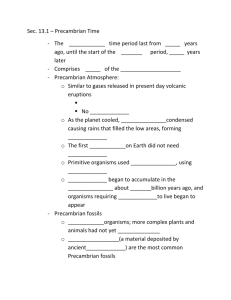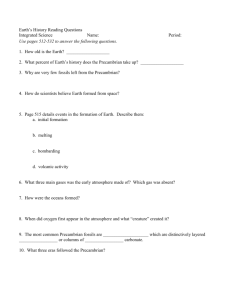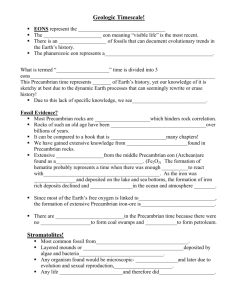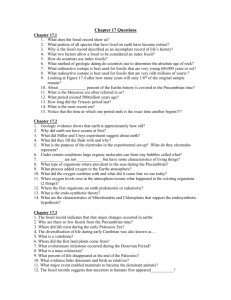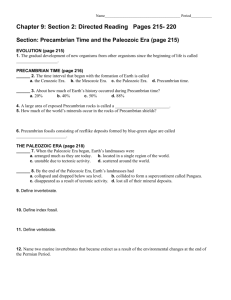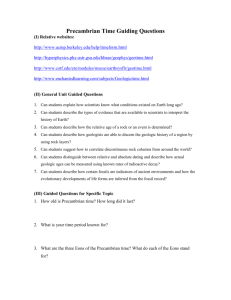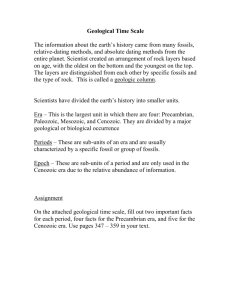Chapter 9 Section 2 Notes
advertisement
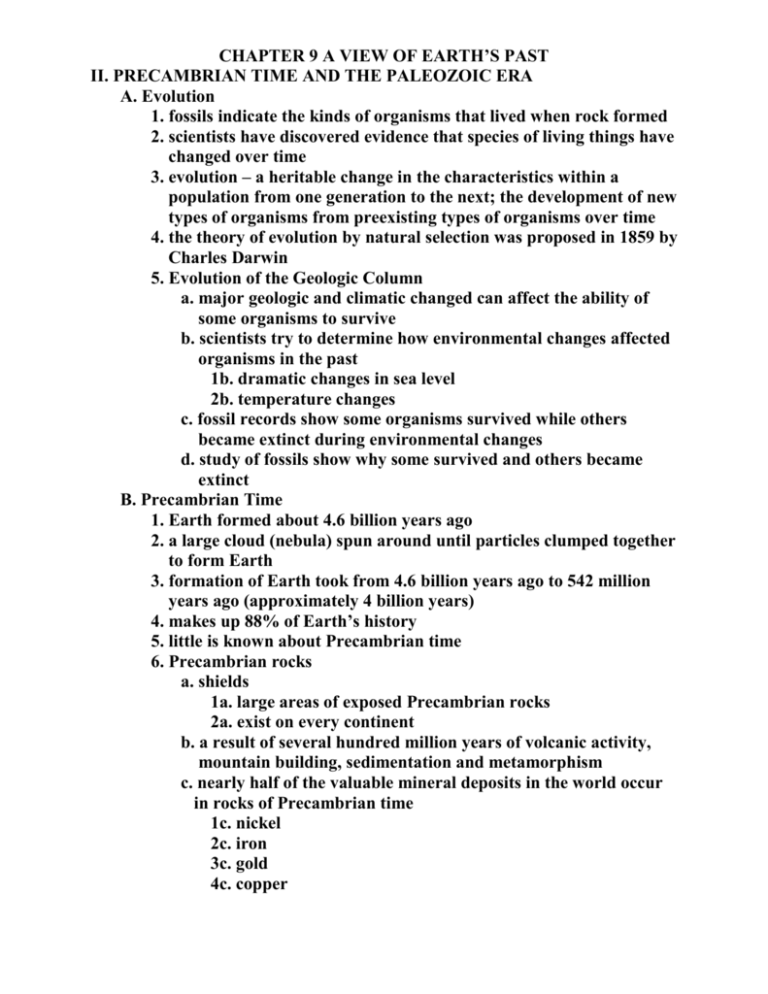
CHAPTER 9 A VIEW OF EARTH’S PAST II. PRECAMBRIAN TIME AND THE PALEOZOIC ERA A. Evolution 1. fossils indicate the kinds of organisms that lived when rock formed 2. scientists have discovered evidence that species of living things have changed over time 3. evolution – a heritable change in the characteristics within a population from one generation to the next; the development of new types of organisms from preexisting types of organisms over time 4. the theory of evolution by natural selection was proposed in 1859 by Charles Darwin 5. Evolution of the Geologic Column a. major geologic and climatic changed can affect the ability of some organisms to survive b. scientists try to determine how environmental changes affected organisms in the past 1b. dramatic changes in sea level 2b. temperature changes c. fossil records show some organisms survived while others became extinct during environmental changes d. study of fossils show why some survived and others became extinct B. Precambrian Time 1. Earth formed about 4.6 billion years ago 2. a large cloud (nebula) spun around until particles clumped together to form Earth 3. formation of Earth took from 4.6 billion years ago to 542 million years ago (approximately 4 billion years) 4. makes up 88% of Earth’s history 5. little is known about Precambrian time 6. Precambrian rocks a. shields 1a. large areas of exposed Precambrian rocks 2a. exist on every continent b. a result of several hundred million years of volcanic activity, mountain building, sedimentation and metamorphism c. nearly half of the valuable mineral deposits in the world occur in rocks of Precambrian time 1c. nickel 2c. iron 3c. gold 4c. copper 7. Precambrian life a. fossils are rare of Precambrian life forms 1a. no bones 2a. no shells 3a. no hard parts 4a. volcanic activity, erosion, crustal movements, metamorphism b. stromatolites 1b. reef-like deposits formed by blue-green algae 2b. form today in warm shallow water 3b. supports the idea that Precambrian rocks were covered by water c. imprints of marine worms, jellyfish and single-celled organisms have been discovered in Precambrian rocks C. The Paleozoic Era 1. 542 million years to 251 million years ago 2. beginning of Era, landmasses scattered 3. Pangaea (single landmass) formed at the end of the era 4. extensive fossil record 5. Divided into seven periods a. The Cambrian Period 1a. first period 2a. warm shallow seas covered much of the Earth 3a. marine invertebrates thrived in the warm water 4a. trilobites are used as index fossils for this period 5a. brachiopods were the second most common invertebrate 6a. no plant life on land b. The Ordovician Period 1b. population of trilobites began to shrink 2b. invertebrate graptolites flourished 3b. vertebrate animals began to appear 4b. no plant life on land c. The Silurian Period 1c. vertebrate and invertebrate life forms flourished 2c. eurypterids existed (Fig. 6, Page 219) 3c. earliest land plants and scorpions evolved on land d. The Devonian Period 1d. “Age of Fishes” 2d. first amphibians began to appear 3d. giant horsetails, ferns and seed bearing plants began to develop 4d. brachiopods and mollusks continued to thrive e. The Carboniferous Period 1e. Mississippian and Pennsylvanian Period 2e. very warm and extremely high humidity 3e. means “carbon bearing” 4e. large coal deposits of today are from this period 5e. vertebrates adapted to life on land resembling large lizards f. The Permian Period 1f. end of the Paleozoic Era 2f. a mass extinction occurred at the end of the Permian Period 3f. Pangaea formed 4f. many species of marine invertebrates disappeared due to retreating, shallow inland seas
